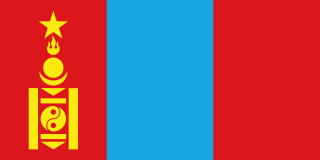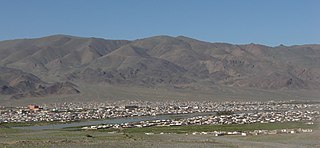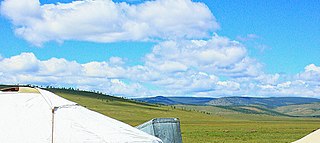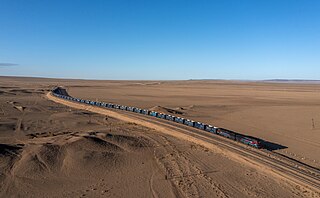
This article on the demographics of Mongolia include population density, ethnicity, education level, health of the populace, economic status, religious affiliations, and other aspects of the population.
Telecommunications in Mongolia face unique challenges. As the least densely populated country in the world, with a significant portion of the population living a nomadic lifestyle, it has been difficult for many traditional information and communication technology (ICT) companies to make headway into Mongolian society. With almost half the population clustered in the capital of Ulaanbaatar, most landline technologies are deployed there. Wireless technologies have had greater success in rural areas.

The transportation system in Mongolia consists of a network of railways, roads, waterways, and airports.

Ulaanbaatar, previously anglicized as Ulan Bator, is the capital and most populous city of Mongolia. With a population of 1.6 million, it is the coldest capital city in the world by average yearly temperature. The municipality is located in north central Mongolia at an elevation of about 1,300 metres (4,300 ft) in a valley on the Tuul River. The city was founded in 1639 as a nomadic Buddhist monastic centre, changing location 28 times, and was permanently settled at its modern location in 1778.
Articles related to Mongolia include:

The Mongolian People's Republic was a socialist state that existed from 1924 to 1992, located in the historical region of Outer Mongolia in China. It was officially recognized by the Nationalist government as independent from the Republic of China in 1946. Until 1990, it was a one-party state ruled by the Mongolian People's Revolutionary Party, and maintained close political and economic ties with the Soviet Union, as part of the Eastern Bloc.

Bayan-Ölgii is the westernmost of the 21 aimags (provinces) of Mongolia. The country's only Muslim and Kazakh-majority aimag, it was established in August 1940. Its capital is Ölgii.

Khentii is one of the 21 aimags (provinces) of Mongolia, located in the east of the country. Its capital is Chinggis City. The aimag is named after the Khentii Mountains. It is best known as the birthplace, and likely final resting place, of Temüjin, otherwise known as Genghis Khan.

Khovd is one of the 21 aimags (provinces) of Mongolia, located in the west of the country. Its capital is also named Khovd.

Erdenet is the second-largest city in Mongolia, with a 2018 population of 98,057, and the capital of the aimag (province) of Orkhon. Located in the northern part of the country, it lies in a valley between the Selenge and Orkhon rivers about 240 km (149 mi) northwest of Ulaanbaatar, Darkhan, the capital. The road length between Ulaanbaatar and Erdenet is about 370 km (230 mi).

Ulaangom is the capital of Uvs Province in Mongolia. It is located on the slopes of the Kharkhiraa mountain, 26 kilometres (16 mi) southwest from Uvs Lake shore and 120 kilometres or 70 miles south from the Russian border.

Ulaanbaatar is divided into nine düüregs or municipal districts: Baganuur, Bagakhangai, Bayangol, Bayanzürkh, Chingeltei, Khan Uul, Nalaikh, Songino Khairkhan and Sükhbaatar. Each district is subdivided into khoroos, of which there are 173. Each düüreg also serves as a constituency that elects one or more representatives into the State Great Khural, the national parliament.

Gorkhi-Terelj National Park is one of the national parks of Mongolia. The Terelj tourist zone has a number of "tourist camps". It is connected with Ulaanbaatar by a paved road. The road comes to the Gorkhiin Davaa pass. Most of the tourist camps and tourist attractions are before this pass. The road then ends at the settlement of Terelj, which features small shops and restaurants. The Terelj settlement is located in the valley of the Terelj River, approximately 66 km from the Ulaanbaatar city center. The national park tourist zone is formally in Nalaikh düüreg (district) part of Ulaanbaatar municipality, the rest of the protected zone beginning to the north of the Terelj River, is located in Mongolia's Töv Province.

Rail transport is an important means of travel in the landlocked country of Mongolia, which has relatively few paved roads. According to official statistics, rail transport carried 93% of Mongolian freight and 43% of passenger turnover in 2007. The Mongolian rail system employs 12,500 people. The national operator is UBTZ, traditionally also known as Mongolian Railway. This can be a source of confusion, since MTZ is a distinct company established in 2008. The Mongolian Railway College is located in Ulaanbaatar.

Tourism in Mongolia was extremely limited by the Socialist Government, but has been expanding following the 1990 Democratic Revolution in Mongolia in the wake of the collapse of the USSR and the Revolutions of 1989. Mongolia is a unique and relatively unexplored travel destination that offers a great combination of scenic natural features, a wide variety of untouched landscapes, nomadic life style and culture. Travel organizations in Mongolia date back to half a century ago, but the private sector-based tourism is barely twenty years old. Now Mongolia boasts 403 travel companies, 320 hotels, 647 resorts and tourist camps, all employing the graduates from over 56 educational establishments. Mongolia takes an active part in United Nations World Tourism Organization, of which it is a member party.
The Baháʼí Faith in Mongolia dates back only to the 1980s and 1990s, as prior to that point Mongolia's Communist anti-religious stance impeded the spread of the religion to that country. The first Baháʼí arrived in Mongolia in 1988, and the religion established a foothold there, later establishing a Local Spiritual Assembly in that nation. In 1994, the Baháʼís elected their first National Spiritual Assembly. Though the Association of Religion Data Archives estimated only some 50 Baháʼís in 2005 more than 1,700 Mongolian Baháʼís turned out for a regional conference in 2009.
The Mongolian Hockey League is the national ice hockey league in Mongolia. It was first contested in 1992.

Zorig Foundation is a Mongolian non-profit, non-governmental organization (NGO) established in October 1998 after the assassination of Mongolian pro-democracy politician Zorig Sanjaasuren. The Zorig Foundation seeks to spread democratic values in Mongolian society; strengthen human rights, and social justice; as well as improve the system of transparency and accountability of the government to the public. In order to meet the above objectives, the Zorig Foundation concentrates its programs in three areas: Youth and Education, Good Governance, and Community Building.

Modern Mongolia inherited a relatively good healthcare system from its socialist period, a world bank report from 2007 notes "despite its low per capita income, Mongolia has relatively strong health indicators; a reflection of the important health gains achieved during the socialist period." On average Mongolia's infant mortality rate is less than half of that of similarly economically developed countries, its under-five mortality rate and life expectancy are all better on average than other nations with similar GDP per capita.

The National Emergency Management Agency or NEMA is a paramilitary government agency overseeing emergency services in Mongolia. It was established with the duty to conduct nationwide post-disaster activities. It is similar to the Russian Ministry of Emergency Situations. It is responsible for developing environmental legislation as well as managing the fall out from natural disasters and conducting rescue work.

















